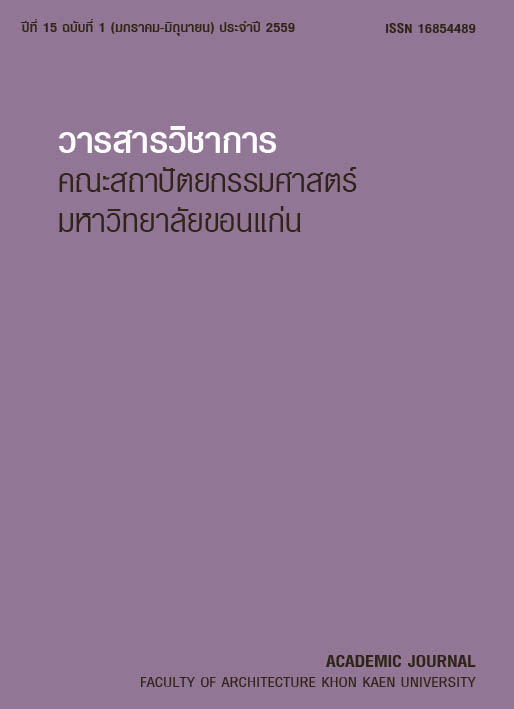แนวความคิดเรื่องสถานที่ และปรากฏการณ์วิทยา กับการศึกษางานสถาปัตยกรรมพื้นถิ่น The Concept of Place and Phenomenology in Study of Vernacular Architecture
คำสำคัญ:
Place, Vernacular Architecture, Methodology, Phenomenology, ความเป็นสถานที่, สถาปัตยกรรมพื้นถิ่น, วิธีวิทยา, ปรากฏการณ์วิทยาบทคัดย่อ
บทคัดย่อภาษาไทย:
แนวความคิดเรื่องสถานที่ในงานสถาปัตยกรรม (Place in Architecture) เป็นกลุ่มของความคิดที่ว่าด้วยความสัมพันธ์ระหว่างมนุษย์กับโลกธรรมชาติที่มีงานสถาปัตยกรรมเป็นตัวกลาง โดยส่วนหนึ่งของแนวคิดพัฒนามาจากปรัชญาปรากฏการณ์วิทยา แนวคิดนี้ในเชิงทฤษฎีเริ่มต้นขึ้นราวปี ค.ศ. 1960 โดยในตอนแรกเป็นการวิพากษ์ “ที่ว่าง”ของยุคสมัยใหม่ที่ขาดการเชื่อมโยงกับชีวิตมนุษย์ ต่อมาในช่วง 25 ปีหลังมาจึงเริ่มพัฒนาไปเป็นองค์ความรู้ที่มีทฤษฎี แนวคิด และวิธีการศึกษาของตัวเอง นอกจากนี้ความหมายของสถานที่มักจะถูกอธิบายเปรียบเทียบกับ หรือมี “ที่ว่าง”รวมอยู่ด้วยเสมอ
ในการศึกษาความเป็นสถานที่ในงานสถาปัตยกรรมนั้น นิยมใช้วิธีการทางปรากฏการณ์วิทยาที่เป็นทั้งวิธีคิดและเครื่องมือในการทำงาน ในเชิงปรัชญาปรากฏการณ์วิทยาต้องการที่จะนำเอาโลกแห่งชีวิตกลับมาสู่การคิดทางปรัชญาอีกครั้ง โดยมีเป้าหมายที่จะศึกษาถึงความดั้งเดิม แก่น รากเหง้าของมนุษย์ ในเชิงวิธีการศึกษา ปรากฏการณ์วิทยาเน้นให้ความสำคัญกับความรู้สึกนึกคิดของมนุษย์ในฐานะบุคคลที่หนึ่ง ซึ่งมีความลึกและหลากหลาย โดยใช้วิธีการทั้งการสอบสวน หรือตีความ ปรากฏการณ์นั้นๆ นอกจากนี้ทัศนคติที่เปิดกว้างของผู้วิจัยยังเป็นสิ่งสำคัญของวิธีการนี้
ตัวอย่างของการใช้ปรากฏการณ์วิทยาในการศึกษาเรื่องสถานที่ก็ได้แก่ งานเขียนของ Christian Norberg-Schulz ซึ่งเสนอการมีอยู่ของสถาปัตยกรรมว่าเกิดขึ้นระหว่าง ผืนดิน-ท้องฟ้า-ภายใน-ภายนอก ข้อเสนอเรื่อง Insideness – Outsideness ของ Edward Relph ซึ่งเสนอว่าความรู้สึกถึงความเป็นสถานที่เกี่ยวข้องกับความเป็นภายในสู่ภายนอก ในแบบต่างๆ 7 แบบ การตีความการรับรู้ของมนุษย์จาก การเคลื่อนไหว น้ำหนัก และความเป็นวัตถุ ในการแสดงออกขององค์ประกอบ พื้น ผนัง หลังคา ในงานเขียนของ Thomas Thiis-Evensen เป็นต้น
ส่วนสุดท้ายของบทความเรื่องนี้เป็นข้อเสนอแนะและข้อสังเกต ที่ได้จากการทบทวนเอกสาร โดยแบ่งเป็นดังนี้ 1)คำอธิบายเรื่องงานสถาปัตยกรรมนั้นตั้งอยู่ระหว่าง ท้องฟ้า-พื้นดิน-ภายใน-ภายนอก ของ Norberg-Schulz 2) ที่ว่าง (Space)สามารถใช้เป็นเครื่องมือหลักในการศึกษาความเป็นสถานที่ได้ 3) มนุษย์คือผู้ให้ความหมายของสถานที่ผ่านการรับรู้ และความทรงจำของมนุษย์ 4) ลักษณะของตัวแปรที่ใช้ในการศึกษาเรื่องความเป็นสถานที่ 5) การศึกษาเรื่องความเป็นสถานที่จากด้านลึก คือการมุ่งหาความดั้งเดิมจากแบบในอดีต และศึกษาความสัมพันธ์ในแนวระนาบของชีวิตประจำวันของช่วงเวลาปัจจุบัน
คำสำคัญ: ความเป็นสถานที่, สถาปัตยกรรมพื้นถิ่น, วิธีวิทยา, ปรากฏการณ์วิทยา
Abstract:
The concept of Place in architecture is a set of thoughts showing the relationship between humans and nature through the medium of architecture. A part of the concepts has developed from phenomenology, which theoretically began around 1960. At first, the idea was formed as an analysis of “space” of period that lacked connection with humans. In the next 25-year period, the idea was developed to be knowledge based on its own theory, concepts and methodology. Besides, the meanings of place are usually compared with space or part of it.
The studying of Place in architecture, it is common to use phenomenology methodology both as a thinking process and working tool. In the light of phenomenology, it aims to bring the world of life back to philosophical thinking again. The objectives are to study originality, root and origin of humans using phenomenological methodology, placing importance on human perception as an individual, which is very multifaceted. Such methodology uses both investigation and interpretation of certain phenomenon. Moreover, the open-mined attitude of the researcher is very important under this methodology.
A good example of using phenomenology approach to study Place can be found in the work of Christian Norberg-Schulz. His interpretation about the being of architecture between earth-sky-insideness-outsideness. The idea of Insideness – Outsideness from Edward Relph proposes that “placeness” involves Insideness and Outsideness in 7 different types. The last example is the interpretation of Thomas Thiis-Evensen which involved in human’s perception such as movement, weight and substance work together with the expressions of floor, wall and roof.
The last part of this article provides suggestions and observations from document review, which can be divided into 1) the definition of the location of architecture between earth-sky-insideness-outsideness of Norberg-Schulz 2) space as a research tool to study placeness 3) the meanings of place given by humans through their perceptions and memories 4) the characteristics of variables used in the study of placeness and 5) the linear and horizontal studies.
Keywords: Place, Vernacular Architecture, Methodology, Phenomenology
ดาวน์โหลด
เผยแพร่แล้ว
รูปแบบการอ้างอิง
ฉบับ
ประเภทบทความ
สัญญาอนุญาต
ทัศนะและข้อคิดเห็นของบทความที่ปรากฏในวารสารฉบับนี้เป็นของผู้เขียนแต่ละท่าน ไม่ถือว่าเป็นทัศนะและความรับผิดชอบของกองบรรณาธิการ




